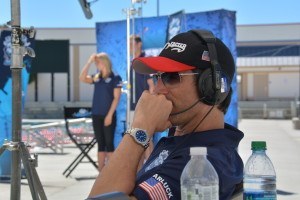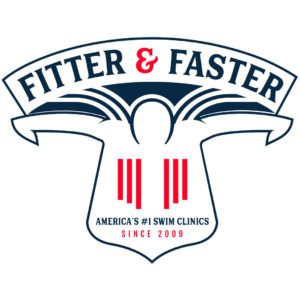 Fitter and Faster 15 Questions (#FFT15) profiles the 50+ elite swimmers and clinicians that host, instruct and manage the world’s largest swim clinic tour.
Fitter and Faster 15 Questions (#FFT15) profiles the 50+ elite swimmers and clinicians that host, instruct and manage the world’s largest swim clinic tour.
In this FFT15, Olympic champion and SwimSwam co-founder, Mel Stewart, sat down with Austin Surhoff, Fitter and Faster Clinician, elite swimmer, University of Texas star, and a man with deep roots in the sport we love.
1. Austin, what do you do at Fitter and Faster?
I’m something of a dual-threat for FFT — my day job is organizing and promoting clinics in my region of the country, but every once in awhile I go into the phone booth, don my cape, and become a clinician.
2. I’ve been an FFT clinician. That’s the fun part. Your day job, organizing and promoting clinics, probably takes a lot of time and focus. I know you’re on the phone a lot talking to clubs and coaches. What’s that like? Since it’s FFT work, are you doing it in your swimsuit?
Not my swimsuit, but close! I can do my job from home, so I am in my sweat pants some (or all) days. Don’t tell anyone…
3. Your secret’s safe with me. Getting back to planning FFT clinics, what do you talk to coaches about?
If I’m planning out a clinic with a coach, we talk about the things they believe their team can improve on the most, whether that’s freestyle, butterfly, starts, whatever it may be. Then I work with them to build a curriculum around it. It’s important that the coaches feel as involved as possible with the process, because I am asking them to promote these clinics to their team’s families. It has to be an experience the coach is confident will be beneficial to their swimmers.
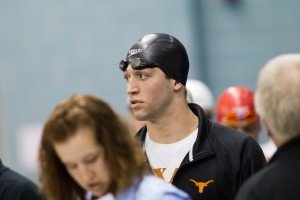 4. You have a long swimming career behind you. What is your most memorable swimming experience?
4. You have a long swimming career behind you. What is your most memorable swimming experience?
#1 is winning the 2010 NCAA Team Title. We had about a third of our team get violently ill the day before the meet started, and still stuck it out to win it. The men who got sick could have quit, but they led by example and refused to let a hospital visit stop them. That was the most inspired I have ever been to perform at my best.
5. Tell us a fun fact about you that not many people know about.
I can do that thing where you cover your nose with your top lip in backstroke kickouts so you don’t have to wear a nose clip or blow out bubbles. Not a lot of people seem to be able to do that.
I’ve also read every single Calvin and Hobbes comic strip. So that’s something.
6. What inspired you to start swimming in the first place?
My parents just..sort of dropped at swim practice one day. I didn’t care for it much until I started getting good and, more importantly, making friends. So my inspiration was my teammates, even then.
7. Your father played 19 seasons of Major League Baseball and your mother was a dominant swimmer for the US National Team and the University of North Carolina. How did their successful careers inspire you to pursue swimming at a higher level?
When I got to be old enough to fully appreciate my parents’ accomplishments and the work they put in to get there (around high school), I realized how much more I was capable of, and how much harder I needed to work in order to get there. Having them was something of a cheat code because I knew I had access to the natural gifts they passed down to me. That little comfort always helped me trust my coaches more than usual because I knew if I worked hard and followed a good plan, I would get to a place of high achievement in the sport. I was lucky.
The biggest takeaway from my mother’s career was dedication. She came up through classic, old-school club programs like NBAC and Germantown academy that liked to grind maximum yardage every day. For an extreme example: she once did a 16,000 straight of 400 IMs at Germantown. Now, I was never going to work that hard, but she was the standard for dedication that I strived to uphold.
My dad set the standard for focus. He is very analytical, and has the ability to pinpoint exactly what needs to be done to get better, always. As I got older, I applied his focus into being a more “thoughtful” swimmer that was always working on something, at all times.
Neither of them ever quit either. My dad made it till he was 40 in the MLB. When I went through the hard times in my career, I was hardcoded to always keep moving; to keep going to practice even if I hated it at the time. It was always worth it to follow that example.
8. You are a coach at Johns Hopkins, what made you want to be a coach?
The mistakes and low-points I experienced in my career, especially in college. I always felt an intense desire to be understood whenever I was struggling, so I want to be able to provide that understanding for college kids going through their own struggles.
On top of that, every single mentor that had a big impact on my life except one (my dad) was a swimmer or a swim coach. I want to pass along what they did for me, and the best way I know how is through coaching.
9. What is it like to be “on the other side” of swimming? Going from a collegiate athlete to a coach.
Honestly, I wish I had been a coach when I was swimming. The first thing I noticed is how much people can sharpen up the little things every single day. I wasn’t very good at that — as technical as I was about “big” stroke changes, it was always the little changes that I had to practice every day that eluded me.
So that being said, I focus intensely on those little things with the kids I coach now. “Do the small things like all things”.
Also, it’s really hard to time like four or five people coming into a wall all at once. That’s going to take some practice.
10. Having that desire to coach, to teach, dovetails with FFT’s mission. How did you first meet the Founder and CEO David Arluck?
I had never met David before last fall. I had seen info about the FFT clinics from afar and admired what they were doing, and knew I wanted to get involved as well. So I actually just found David on Facebook, and reached out to him about how much I wanted to start doing them. He was down with that idea.
11. What can swimmers that attend your FFT swim clinics get out of learning from you?
They can learn about “details under duress”. Every single swimmer I work with, whether it’s a 10 year old that just wants to make a state meet, or a college kid that’s won an NCAA title, can get better at doing the little technical things right no matter how tired they get in a race. It’s the first thing to go when you are exhausted — the streamline loosens, you take less kicks off the last wall, you breathe the stroke before the finish. It is important to me to make people aware of these little details, and get better at doing them when it feels like they have nothing left to give.
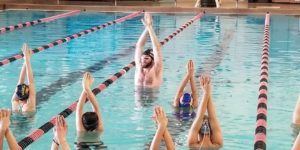 12. What is your favorite thing to teach at FFT swim clinics?
12. What is your favorite thing to teach at FFT swim clinics?
Streamlines. I love having the swimmers do streamline competitions — how far they can go pushing off the wall with no strokes or kicks — because a little competition has a way of drawing the best out of kids.
13. Have you learned anything about yourself through coaching at swim clinics?
I’ve always known that I enjoyed public speaking, but now I know that I like to take it a few steps further and work with a captive audience in an interactive way, instead of just talking at them. People learn more effectively when they can process new concepts a few different ways. At FFT clinics, they 1. hear the concept when I explain it, 2. See the concept in action when I demonstrate it, and 3. Feel the concept in action when they try it for themselves. It’s very sophisticated learning that takes place.
14. What is your favorite experience that you’ve had through Fitter and Faster?
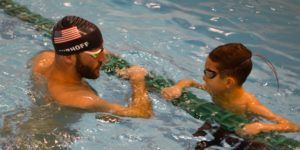 At the end of every clinic, we have a 20-30 minute Q&A session with the swimmers and their parents. Any time I get to answer the question, “How do you know if you had a good meet?”,
At the end of every clinic, we have a 20-30 minute Q&A session with the swimmers and their parents. Any time I get to answer the question, “How do you know if you had a good meet?”,
I tell them this story:
At the 2016 Olympic Trials, I got touched out for 8th place in the semifinal of the 200 IM by 3/100ths of a second. I got 9th place, and 8 people made it back to finals. My career was over — I had had a “bad” meet because I didn’t accomplish my goal of making it back to the final of the olympic trials, and it had happened in less time than it takes to snap your fingers. The other guy might have just touched the wall harder, who knows. But I walked over to the warm down pool, and I was miserable. I shook my coaches’ hands, thank them, and walked away, knowing I was going to regret this night for a long time.
But then, 10 minutes later, Derek Schmitt (ASU’s assistant) ran over to me, and told me to get back in the warm down pool. I had been scratched into the final. Someone, at the OLYMPIC TRIALS, decided to scratch. That never happens.
I was elated. I had accomplished my goal. I had had a “good” meet, and I now live a life free of any regrets about my career.
Now, looking back, I realize the error of my thinking. I had let my feelings about my entire career become completely dependent on 3/100ths of a second, and someone else scratching from an Olympic Trials Final. I gave away the power to define my own success. I never want to do that again.
A swimmer will know if they had a good or bad meet if 1. They competed to the level they trained for. 2. They executed their plan they worked with their coach to come up with. 3. They controlled their preparation and recovery outside of the pool to the best of their abilities. That’s all we can do.
15. If you chose one thing you hope the participants learn from you at the Fitter and Faster clinics you lead, what would that be?
Everyone has the right to be the hero of their own story. These can have control over how they define their success, they just have to take the time to search for what that means to them within themselves instead of only depending on their coaches/parents/peers to define their success for them.
Also, valuing process over results is immensely important. Long-term goals without short-term goals are wishes. If you don’t have a path to your “big” goals built around a sound process, you might as well be chucking pennies into a fountain.
Subscribe to Swim Videos on Demand here.
Follow Fitter and Faster on Instagram here.
Follow Fitter and Faster on Twitter here.
Like Fitter and Faster on Facebook here.
About the Fitter and Faster Swim Tour
The Fitter & Faster Swim Tour produces swim clinics featuring elite stars of the sport and the most innovative teaching platforms. FFT Swim Clinics can be customized to meet age and skill level of every team and community. Call 786-837-6881 or visit http://www.fitterandfaster.com/ to learn more.
Swimming feature Q&A is courtesy of Fitter and Faster Swim Tour, a SwimSwam partner.

